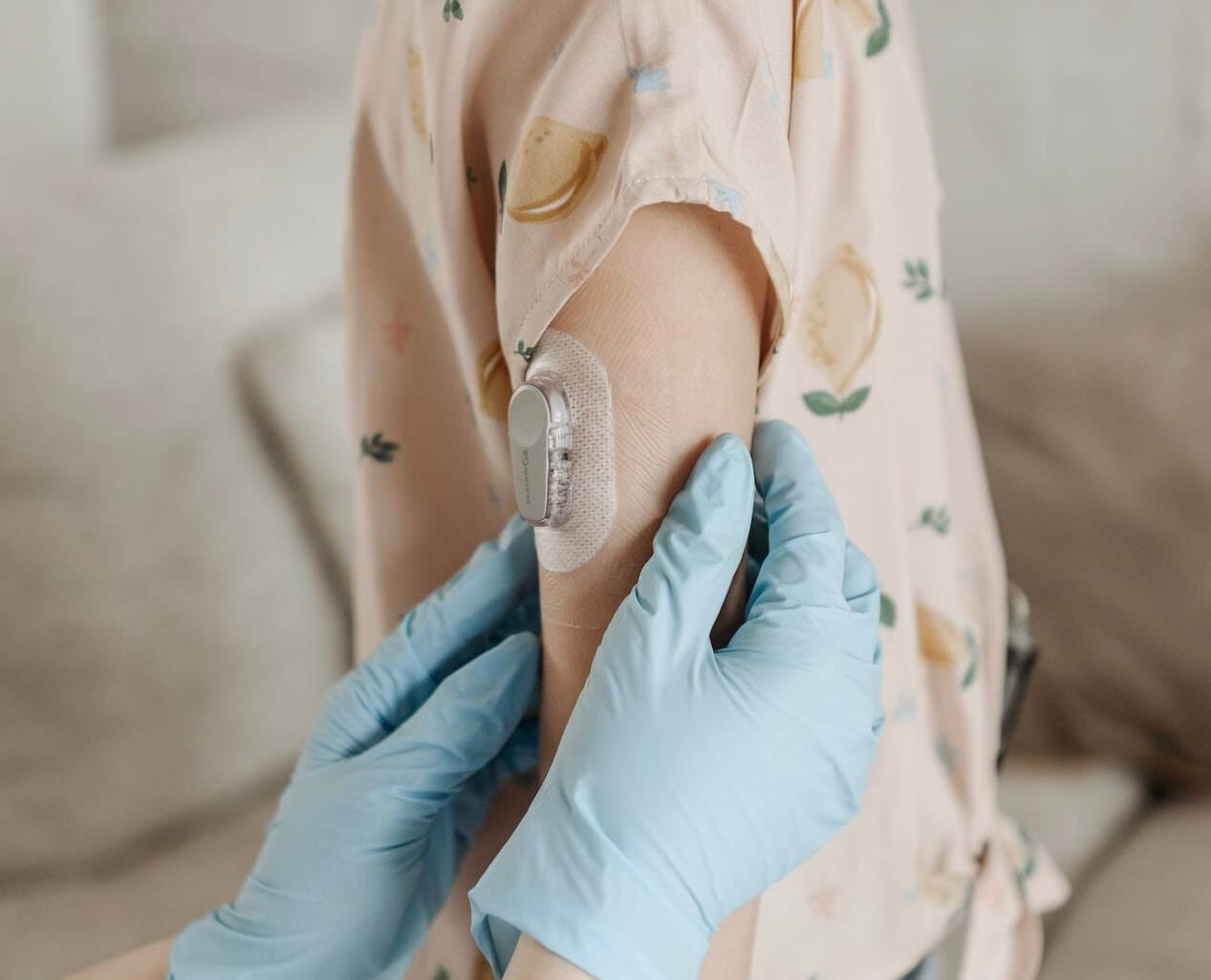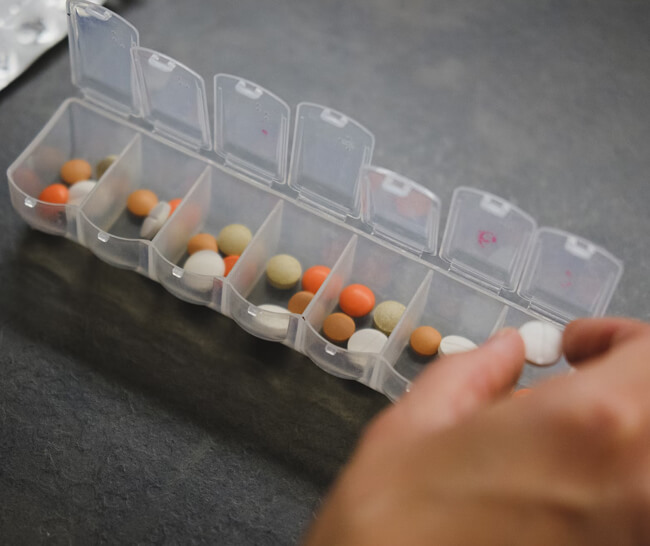While diet culture is still pervasive, there's been a significant shift from trendy diets to a better understanding that health is more than what we see on the outside. Wellness is no longer confined to physical aesthetics alone; instead, it revolves around optimizing our body's performance at a cellular level. Continuous Glucose Monitors (CGMs) have emerged as a valuable tool in this pursuit, enabling us to obtain real-time insights into our metabolic health.
Initially made for people living with diabetes, CGMs are making waves in the wellness world as a tool for optimizing metabolic health. At the same time, when a wellness tool becomes more popular, it's harder to separate the myths versus reality about usability, effectiveness, and relevance to the average person. Here, we'll dive deep into the facts about CGMs so you can make the right choice for your body.
Continuous Glucose Monitor 101: What's a CGM and How Does it Work?
A continuous glucose monitor is a device that measures glucose (blood sugar) levels in the body throughout the day. Unlike a blood test, CGMs measure glucose concentrations in the interstitial fluid (ISF) and send the data to a reader. Data collected by these devices provides real-time insights into blood sugar levels as well as trends and patterns over time.
CGMs were initially made for people living with diabetes to support blood sugar management. With the recognition that metabolic health and blood sugar regulation matter not just for people with diabetes but for everyone, CGMs have become a tool to support healthy behavior change. Studies suggest that seeing real-time feedback on health metrics can help people stay motivated to make positive health behavior changes.
Top Myths About CGMs
Now that we have some background, let's look at the top misconceptions about CGMs. Understanding exactly what information a CGM can tell you (and what it can't) can help you utilize CGMs to their full potential and support your metabolic health.
Myth #1: Wearing a CGM Takes the Place of Other Blood Sugar Labs
Reality: A CGM is a tool to track and monitor your blood sugar over time, but it should not be used as the only measure of your glucose levels. Let's explore the differences between the types of glucose tests (note: this is assuming you do not have diabetes):
- Fingerstick glucose: A fingerstick glucose test is done with a blood sample taken from your fingertips. This type of test reflects your current glucose levels at that moment but does not provide you with trends over time.
- Continuous Glucose Monitor: A CGM provides continuous tracking of your blood sugar levels throughout the day and long-term trend analysis. As a CGM collects data every few minutes and stores more data points than a fingerstick glucose test, it can provide real-time feedback on your blood sugar levels.
- Fasting glucose: A fasting glucose test is done in a lab with a blood sample taken for 8 to 12 hours after fasting. As a baseline, fasting blood sugar can help identify long-term trends like insulin resistance and other metabolic issues.
- Hemoglobin A1c: A Hemoglobin A1c is a blood test that reflects your average glucose level over the last two to three months. It's used clinically to diagnose diabetes and monitor blood sugar management.
CGMs give you insight into your daily glucose levels but can't be used to diagnose diabetes or prediabetes. Annual physical exams that include fasting glucose tests and hemoglobin A1C are essential for understanding your overall health.
CGMs are an excellent tool to support these exams by providing a more comprehensive picture of how your blood sugar levels respond to food, activity, stress, and other lifestyle habits so you can make positive changes that will also be reflected in these other tests.
Myth #2: Attaching or Wearing a CGM Is Painful and Uncomfortable
Reality: If the idea of attaching or wearing a device that attaches under your skin makes you feel a little uncomfortable, you're not alone. Many people worry that CGMs are painful and picture a CGM similar to inserting a needle like a fingerstick.
CGMs are a very gentle and non-invasive option for monitoring glucose levels. The sensor under the skin is very thin and typically causes minimal discomfort when inserted. It's very different from a needle or syringe injection because it only tests interstitial fluid right below the skin (unlike a blood test). Studies on CGMS that also measured adherence (how well people continue to use the device) have shown that CGMs are well-tolerated.
Occasionally, some notice that the adhesive used to keep the device in place can cause skin irritation. Still, there are other options available to help minimize this possibility. After a few days, most people find that they no longer even notice the sensor and barely recognize it's there.
Myth #3: CGMs Aren't Beneficial for Healthy Individuals
Reality: Even though CGMs were designed for people living with diabetes, that doesn't mean healthy people can't utilize them for health benefits. Monitoring your glucose levels can provide valuable insights into how your body responds to different foods, exercise, and stress, helping you optimize your overall health and well-being.
Healthy individuals can benefit from understanding their glycemic variability, which is the degree to which your blood sugar fluctuates throughout the day. High glycemic variability can indicate that your body is having difficulty maintaining steady blood sugar levels, which can lead to energy dips and mood swings and may even increase the risk of developing metabolic conditions in the long term.
A CGM can help you pinpoint the foods or activities that cause these big spikes or dips in your blood sugar levels and adjust your lifestyle accordingly. This way, CGMs can be a proactive, personalized tool for optimizing your health and lowering the risk of developing a metabolic condition.
Myth #4: You Should Never See Your Blood Sugar Spike on a CGM
Reality: It's normal to sometimes experience spikes or dips in your blood sugar. Your body is designed to adjust and regulate itself, so noting the rise and fall of blood sugar is a sign that things are working as they should.
The key point to remember is that too much of anything is never good. The body wants to be balanced where it can, so if you're seeing frequent or sustained spikes in your blood sugar levels, this may indicate that your diet and lifestyle need to be adjusted to restore balance.
You may also notice that blood sugar stays higher after a spike, indicating that your body has difficulty managing glucose levels. Or you may see after an increase and subsequent drop, your blood sugar has additional spikes while you're sleeping, so you wake up higher with a fasting morning sugar. By monitoring your CGM data, you can note patterns and what types of foods or activities cause these significant fluctuations in your blood sugar levels and adjust if it's a regular occurrence.
Myth #5: CGMs Only Give Information About How Food Impacts Blood Sugar
Reality: While it's true that CGMs provide invaluable data on how different foods affect your blood sugar levels, they also offer insights into other crucial aspects of your health.
For example, physical activity can have profound effects on your glucose levels. You may notice that high-intensity exercise temporarily increases blood sugar but lowers daily glucose levels. This is a normal physiological response where your body releases glucose into your blood, and your cells effectively use it for energy to power your workout.
By monitoring your CGM during and after workouts, you can understand how various types of exercise impact your blood sugar and adjust your regimen accordingly. Studies also show that people who use CGMs may feel motivated to make positive exercise changes.
CGMs can also reveal how sleep patterns and stress levels influence blood sugar. Chronic lack of sleep or high stress can lead to persistent elevations in blood sugar. If you notice a correlation between these factors and higher glucose levels, it could be a wake-up call to prioritize better sleep hygiene or stress management techniques.
In essence, a CGM does more than just monitor food's impact on your blood sugar; it gives you a comprehensive view of how various lifestyle factors affect your metabolic health, empowering you to make positive changes for better overall health.
Myth #6: Using a CGM Gives You a Step-by-Step Diet Guide
Reality: While a CGM delivers invaluable insights about your metabolic health, it's essential to know that it does not come with a step-by-step guide for weight loss or other health improvements. Yes, it tells you how your body responds to different foods, activities, and lifestyle choices, but decoding this information into actionable steps could be challenging. This is where working with a professional or pairing your CGM with an app like Signos can be a game-changer.
Signos uses real-time data from your CGM and translates it into personalized guidance and support. It helps you understand your body's unique responses and provides practical advice regarding diet, exercise, and other habits to assist you in making simple, lasting changes.
For example, if your CGM shows that certain foods cause a quick rise in blood sugar, Signos can suggest alternative options. Studies indicate that when CGMs provide personalized feedback, they can help make behavior changes, understand hunger cues, and keep you on track.
Takeaway: CGMs Can Be A Powerful Tool for Optimal Health
A continuous glucose monitor provides real-time insight into how your daily nutrition, sleep, stress, and exercise habits influence your blood sugar. A CGM won't do all the work to "fix" metabolic health on its own. Still, when real-time glucose readings are combined with feedback and suggestions to support positive changes, it can be a powerful and motivating tool for optimizing long-term health.
- Item 1
- Item 2
- item 3
Topics discussed in this article:
References
- Lee, I., Probst, D., Klonoff, D., & Sode, K. (2021). Continuous glucose monitoring systems - Current status and future perspectives of the flagship technologies in biosensor research -. Biosensors and Bioelectronics, 181, 113054. https://doi.org/10.1016/j.bios.2021.113054
- Liao, Y., Basen-Engquist, K. M., Urbauer, D. L., Bevers, T. B., Hawk, E., & Schembre, S. M. (2020). Using Continuous Glucose Monitoring to Motivate Physical Activity in Overweight and Obese Adults: A Pilot Study. Cancer epidemiology, biomarkers & prevention : a publication of the American Association for Cancer Research, cosponsored by the American Society of Preventive Oncology, 29(4), 761–768. https://doi.org/10.1158/1055-9965.EPI-19-0906
- Mathew, T. K., Zubair, M., & Tadi, P. (2023). Blood Glucose Monitoring. In StatPearls. StatPearls Publishing.
- Hegedus, E., Salvy, S. J., Wee, C. P., Naguib, M., Raymond, J. K., Fox, D. S., & Vidmar, A. P. (2021). Use of continuous glucose monitoring in obesity research: A scoping review. Obesity research & clinical practice, 15(5), 431–438. https://doi.org/10.1016/j.orcp.2021.08.006
- Holzer, R., Bloch, W., & Brinkmann, C. (2022). Continuous Glucose Monitoring in Healthy Adults-Possible Applications in Health Care, Wellness, and Sports. Sensors (Basel, Switzerland), 22(5), 2030. https://doi.org/10.3390/s22052030
- Gude, F., Díaz-Vidal, P., Rúa-Pérez, C., Alonso-Sampedro, M., Fernández-Merino, C., Rey-García, J., Cadarso-Suárez, C., Pazos-Couselo, M., García-López, J. M., & Gonzalez-Quintela, A. (2017). Glycemic Variability and Its Association With Demographics and Lifestyles in a General Adult Population. Journal of diabetes science and technology, 11(4), 780–790. https://doi.org/10.1177/1932296816682031
- Adams O. P. (2013). The impact of brief high-intensity exercise on blood glucose levels. Diabetes, metabolic syndrome and obesity : targets and therapy, 6, 113–122. https://doi.org/10.2147/DMSO.S29222
- Whelan, M. E., Orme, M. W., Kingsnorth, A. P., Sherar, L. B., Denton, F. L., & Esliger, D. W. (2019). Examining the Use of Glucose and Physical Activity Self-Monitoring Technologies in Individuals at Moderate to High Risk of Developing Type 2 Diabetes: Randomized Trial. JMIR mHealth and uHealth, 7(10), e14195. https://doi.org/10.2196/14195
- Sharma, K., Akre, S., Chakole, S., & Wanjari, M. B. (2022). Stress-Induced Diabetes: A Review. Cureus, 14(9), e29142. https://doi.org/10.7759/cureus.29142
- Hegedus, E., Salvy, J., Wee, C. P., Naguib, M., Raymond, J. K., Fox, D. S., & Vidmar, A. P. (2021). Use of Continuous Glucose Monitoring in Obesity Research: A Scoping Review. Obesity Research & Clinical Practice, 15(5), 431. https://doi.org/10.1016/j.orcp.2021.08.006
































